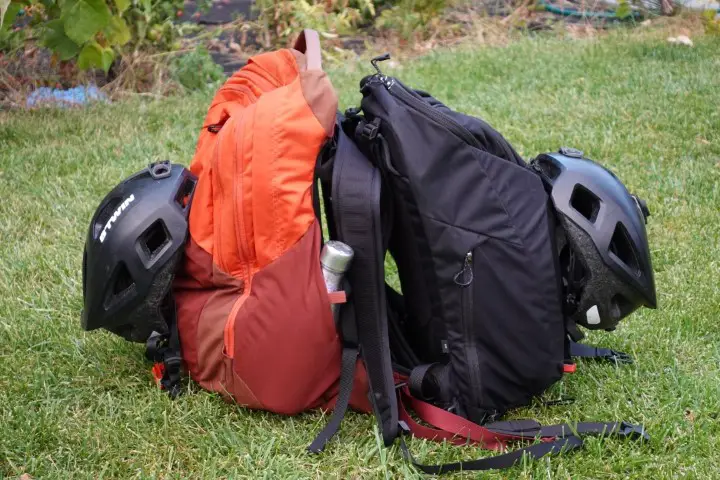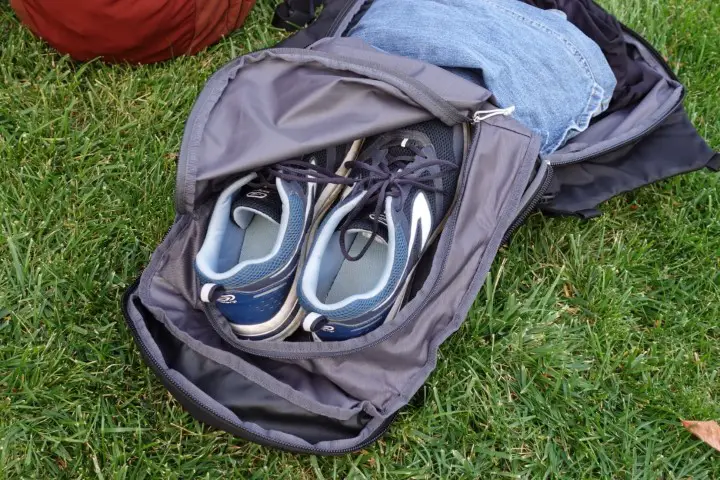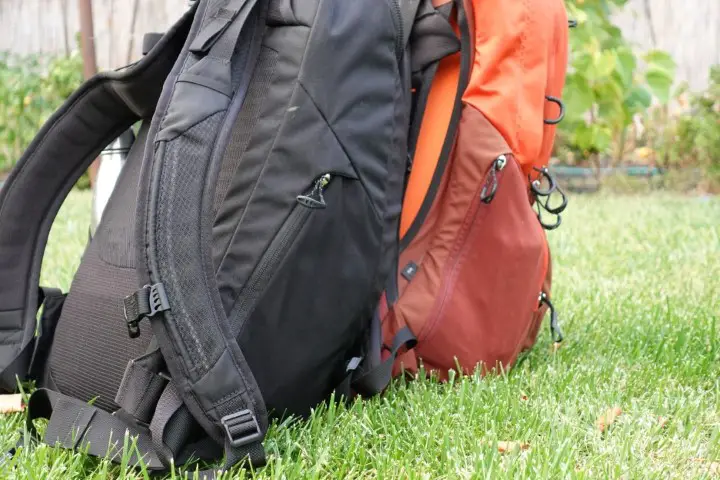A good cycling backpack can change the way you ride your bike. It influences your posture, comfort. After having used a number of backpacks the Osprey Radial and Metron are both on my top recommended list. They are both very well built and very functional backpacks for cyclists. Let’s compare them side-by-side so you can decide which one is better for you.
The Osprey Metron is the little brother of the Radial in every aspect. It shares the same great build quality and practical features in a smaller form factor, but it lacks some of the advanced features of the Radial. The Metron is better for those who carry fewer things and prefer a more ergonomic form factor, while the Radial is better for those who need room for extra cargo in the backpack.

Let’s dive into the details.
| Radial | Metron | |
| Empty weight | 1640g | 1260g |
| Capacity | 26-34 l | 26 l |
| Ventilation | Airspeed | Airscape |
| Harness system | Fully adjustable back panel Fully adjustable straps | One-size back pannel Fully adjustable straps |
| Number of pockets | 6 | 6 |
Appearance
At first glance, the Radial and the Metron look very different from each other, which is immediately apparent in three aspects.
Electric bikes built for everything and priced for everyone. Shop Rad Power Bikes, America's #1 electric bike brand. Get out. Go further. Ride Rad.
The first, immediately apparent one is that the Radial has a classic backpack look, while the Metron is dominated by two compression straps that Osprey calls a straight jacket, which offers some flexibility to compress the backpack when not fully loaded, and it also gives some flexibility if you want to carry something that doesn’t fit inside (e.g a jacket).

The second difference you’ll spot is how they sit on your back. A distinguishing feature of both of these Osprey bags compared to most other backpacks is that they both offer ventilation to our backs.
The Radial has Airspeed. It is suspended on a mesh trampoline, which is completely detached from the rest of the backpack. The only thing that comes in contact with your body is the mesh, which offers full ventilation. It runs all the way down to the bottom of the bag.
The Metron has Airscape, which offers partial ventilation. The backpack is still in contact with your body, but it has some grooves for air to pass through. Unlike Airspeed, it doesn’t run all the way down, but it stops 2/3 of the day down, blocking the air from your lower back.

I love that the trampoline suspension allows the Radial to be fully adjustable in height. If you have a particularly long or short torso, you can fully adjust where the bag sits so it fits your needs completely. The Metron lacks this feature completely. It’s still a comfortable backpack, but it’s less flexible than the Radial.

The third main noticeable difference is that the Radial has a built-in kickstand, which is completely missing on the Metron. The kickstand allows the Radial to stand upright whether it’s empty or loaded. I’ve found that unless you fully load it, it’s not going to fall over. The Metron, on the other hand, has a rounded bottom, which makes it difficult to balance even if you lean it against something.
When you get past these main differences, you will notice that both backpacks have a lot in common.
They both have a sternum strap with a built-in whistle in the buckle as well as a waist strap, which, in a curious way, is wider on the Metron than on the Radial. They both have LidLock, a clever way of attaching a helmet to the backpack when you’re off your bike.

The LidLock allows you to attach your helmet easily 
They are made of the same durable material and they both have the same elastic pockets. The pocket layout is also identical on both.

Size and layout
The Radial and the Metron both share an identical layout. Every single pocket found on the Radial is present on the Metron. This means that you can organize your belongings in the Metron just as easily as in its bigger brother. The difference is in the size of these compartments.
| Radial | Metron | |
| Main pocket with 2 laptop sleeves and shoe compartment | Expandable | Non-expandable |
| Secondary pocket for smaller items | Reaches to the bottom of the bag Has many small pockets | Reaches 2/3 down Has many small pockets |
| Quick access front pocket | With soft inner lining | With soft inner lining |
| Front elastic pouch | Present, large | Present, medium size |
| Side pockets | Present One with zipper and one open | Present One with zipper and one open |
| Bottom pocket for rain cover | Present, slightly larger | Present, slightly smaller |
The large compartment of the Radial is larger than the Metron even when it’s not expanded, and when you open the expansion zipper, the size nearly doubles. If you’re a commuter, it can fit an entire week’s worth of t-shirts and pants, or you can fit a lot of groceries on your way home.
In order to get full access to the Metron’s large pocket, you need to undo the compression straps. This is a little bit annoying since opening the top only allows you to have very limited access to its contents.
Both bags have two sleeves inside the main pocket: one for a laptop and another one for a tablet or some notes. They both have a separate shoe compartment in the large pocket also.
The second pocket is a well-organized one on both backpacks, which is perfectly suitable to carry smaller items such as a charger, a power bank, a mouse, pens, and dongles. The layout is identical, but the size in the Radial is larger than in the Metron.
Both have a quick access pocket on the front of the backpack as well as an elastic pouch. The quick-access pocket has a soft plastic lining to keep items such as sunglasses or phone screens free from scratches. I keep finding myself using this pocket for my bike lights and bike computer when I get off the bike. It’s large enough to hold all of them, but it’s small enough so I don’t have to fish for things at the bottom of a large pocket.
The elastic front pouch is handy to keep medium-large items such as locks, or even a light cycling jacket. I always carry my AirPannier here in case the backpack gets too heavy to carry or the weather is too hot, and I want full ventilation to my back. It is also handy in case I need to carry something that doesn’t fit inside the backpack. You can check out my full review of it here.
The Radial and the Metron both have two side pockets made out of the same elastic material as the front pouch. They conveniently disappear when empty, but they are great for keeping water bottles, keys, or wallets too. Since they are angled towards you when you have the backpack on, you can reach for the contents without having to take it off. One of them has a zipper to prevent things from falling, while the other one is fully open so you can place a larger water bottle in it.
There’s a pocket on the bottom of the backpacks, which holds the rain cover included in the purchase. It takes 30 seconds to put it on the backpack, and it offers full protection against water. Both the Metron and the Radial offer good waterproofing when fitted with the rain cover.
As a side note, I will remark that this pocket is slightly bigger on the Radial, which allows me to keep my bicycle tools in it. It’s a convenient way of storing stuff that I may occasionally need at all times, but I don’t want to keep in one of the main pockets.
Comfort and Quality
Osprey is well-known for making excellent quality bags, and the Radial and the Metron are no different.
The very first contact with the backpack is by the handles, which are the same on both, and are pleasant to the touch and comfortable to hold. The straps are well-padded and offer good comfort even under heavy loads. The load-bearing straps on the top and the adjustable sternum strap help you to dial in the perfect fit.
The weight is distributed evenly and there’s a slight curvature to the back panel so you won’t feel uncomfortable when you’re on the bicycle but they are both comfortable to wear as everyday carry packs too.
After 18 months of intense use, the Radial is completely intact. I’ve used it in the rain, sun as well as snow. I’ve taken it on hikes and laid it on the ground, I had it knocked against walls, scraped it in bushes. The backpack has gotten dirty, but the material hasn’t freied. Since the Metron is made of the exact same material, I’m confident that it is going to be just as lasting as the Radial.
The stitching is excellent and the attention to detail is noticeable on both backpacks. There is a loop to attach bicycle lights to on the front of the backpack as well as reflective details on both the strap and the front. The zippers are YKK zippers very easy to move with just one finger because of the finger loops built-in.

Which one is for you?
If you’re still trying to figure out whether you need the Radial or the Metron, let me offer you some help.
Choose the Radial if you:
- neeed a large capacity backpack to carry an entire week’s worth of clothes or for the occasional grocery shopping
- have an unusually long or short torso
- need a backpack that stands by itself
- full ventilation to your back
Choose the Metron if you:
- want a well-organized backpack, but you don’t need the extra size
- want a more aerodynamic form factor
- prefer a lighter bag
- prefer the way it looks.
In my opinion, the Radial is a better option for most people because it has some features that the Metron lacks, but the choice is yours ultimately. Either way, you will have no regrets.
Happy pedaling!
















